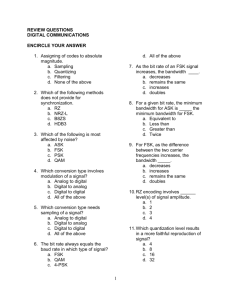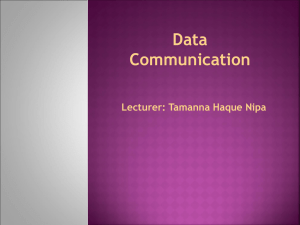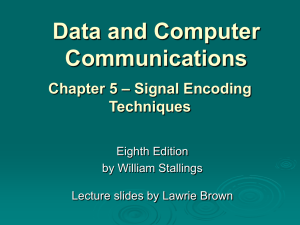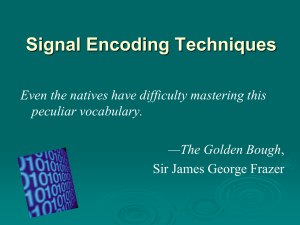chapter_5_part3
advertisement
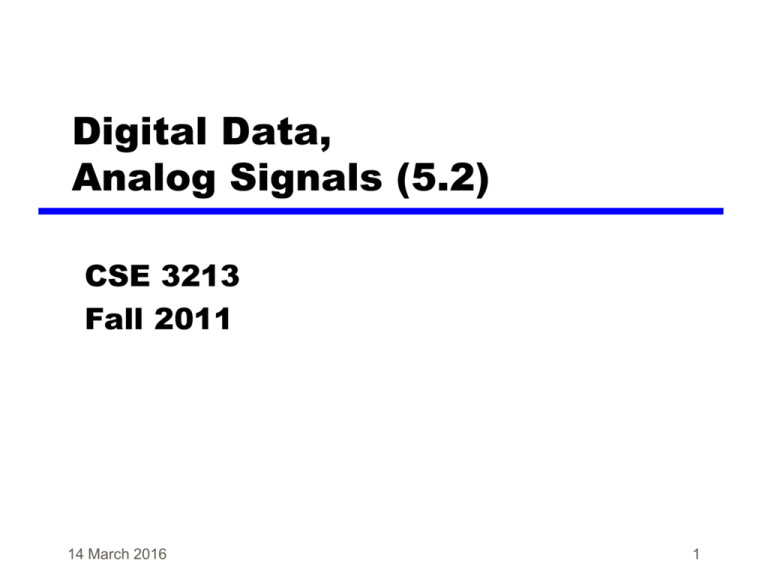
Digital Data, Analog Signals (5.2) CSE 3213 Fall 2011 14 March 2016 1 Digital Data, Analog Signal Encoding Techniques main use is public Frequency shift keying (FSK) (ASK) • most • used to common transmit form is digital binary data over FSK optical (BFSK) fiber Amplitude shift keying Phase shift keying (PK) • phase of carrier signal is shifted to represent data telephone system has frequency range of 300Hz to 3400Hz uses modem (modulatordemodulator) Modulation Techniques 3 Amplitude Shift Keying A sin(2f c t ) binary 1 s (t ) 0 binary 0 • Values represented by different amplitudes of carrier • Usually, one amplitude is zero — i.e. presence and absence of carrier is used • • • • Susceptible to sudden gain changes Inefficient Used for voice grade lines (up to 1,200 bps) Used over optical fiber (e.g., 1 = light pulse; 0 = no light) 4 Binary Frequency Shift Keying A sin(2f1t ) binary 1 s(t ) A sin(2f 2t ) binary 0 • Most common form is binary FSK (BFSK) • Two binary values represented by two different frequencies (near carrier) • Less susceptible to error than ASK • Used for — Up to 1,200 bps on voice grade lines — High frequency radio (3-30 MHz) — Even higher frequency on LANs using coaxial cable 5 Multiple FSK each signalling element represents more than one bit more than two frequencies used more bandwidth efficient more prone to error FSK on Voice-Grade Line Phase Shift Keying A sin( 2f ct ) binary 0 s(t ) binary 1 A sin( 2f ct ) • Phase of carrier signal is shifted to represent data • Binary PSK — Two phases represent two binary digits • Differential PSK — Phase shifted relative to previous transmission rather than some reference signal — Binary 0: same phase as previous signal burst — Binary 1: opposite phase to previous signal burst 8 Differential PSK 9 Quadrature PSK A sin(2f c t / 4) binary 11 A sin(2f t 3 / 4) binary 10 c s(t ) A sin(2f c t 5 / 4) binary 01 A sin(2f c t 7 / 4) binary 00 • More efficient: each signal element representing more than one bit — QPSK: each element represents two bits 10 PSK Combined with ASK • 9600 bps modem use 12 angles, four of which have two amplitudes 11 Performance of Digital to Analog Modulation Schemes bandwidth ASK/PSK bandwidth directly relates to bit rate multilevel PSK gives significant improvements in presence of noise: bit error rate of PSK and QPSK are about 3dB superior to ASK and FSK for MFSK and MPSK have tradeoff between bandwidth efficiency and error performance Performance of Digital to Analog Modulation Schemes • Transmission bandwidth: — ASK and PSK bandwidth directly related to bit rate — FSK bandwidth related to data rate for lower frequencies, but to offset of modulated frequency from carrier at high frequencies — Roll-off factor r depends on technique for filtering signal to establish B ASK : BT (1 r ) R; r rolloff factor; 0 r 1 BT 2f (1 r ) R; f f 2 f c f c f1 BT (1 r ) R; (1 r ) Multilevel PSK : BT R; L no. of levels log 2 L FSK : PSK : 13 Bandwidth Efficiency for Digital-toAnalog Encoding Schemes R/BT Analog Data, Analog Signals (5.4) CSE 3213 15 Analog Data, Analog Signals • Why modulate analog signals? — Higher frequency can give more efficient transmission — Permits frequency division multiplexing (Chapter 8) • Combining an input signal m(t) and a carrier of frequency fc to produce a signal s(t) whose bandwidth is centered at fc — m(t): modulating signal — s(t): modulated signal • Types of modulation: Amplitude Modulation : s (t ) [1 na x(t )] cos 2f c t na modulation index Phase Modulation : s (t ) Ac cos2f c t (t ) (t ) n p m(t ); n p modulation index Frequency Modulation : s (t ) Ac cos2f c t (t ) ' (t ) n f m(t ); n f modulation index 16 Analog Modulation 17 Transmission Bandwidth of Analog Modulation Schemes • FM and PM require greater bandwidth than AM. • B is the bandwidth of the original signal. AM : BT 2 B PM / FM : BT 2( 1) B for PM Am n p where Am n f for FM 2B and Am is the maximum value of m(t ) 18 Summary Signal encoding techniques digital data, digital signal • NRZ, multilevel binary, biphase • modulation rate, scrambling techniques analog data, digital signal • PCM, DM digital data, analog signal • ASK, FSK, BFSK, PSK analog data, analog signal • AM, FM, PM Reading • Chapter 5, Stallings’ book • Next time: Digital Data Communications Techniques (chapter 6) 20
